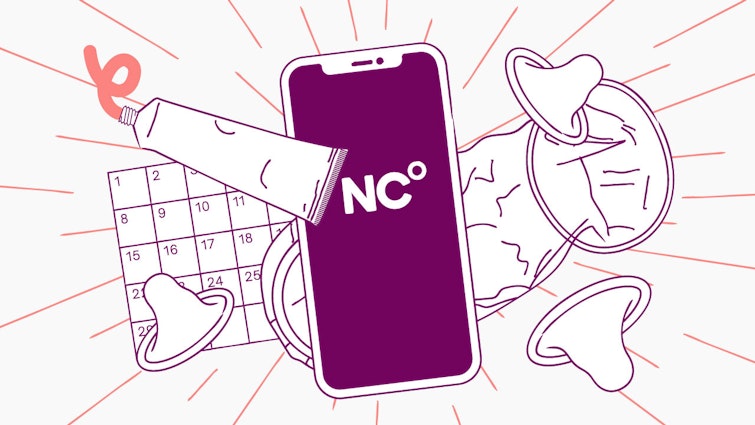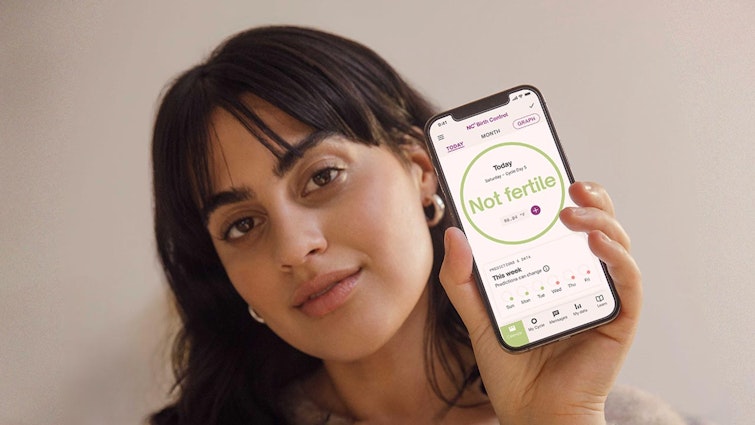Natural Birth Control Explained
Looking for an alternative to hormonal birth control? Curious about how other contraceptive methods work? Or maybe you’re just wondering ‘what is natural birth control?’ In this article, we’re going to take a deep dive into the topic of natural birth control. We’ll take a look at different types of natural birth control from calendar methods to birth control apps. We’ll also cover how natural birth control works, how effective it is, and more.

What is natural birth control?
Natural birth control isn’t just one thing, in fact, it’s a group of contraceptive methods that offer an alternative way to prevent pregnancy, without hormones or invasive devices.
Natural birth control isn’t quite the same as hormone-free birth control, although all natural birth control is hormone-free, some invasive or barrier methods don’t contain hormones, but aren’t considered natural - for example, the copper IUD.
Typically natural birth control involves monitoring a set of signals known as ‘fertility indicators’. These are a collection of biological signs that can show you where you are in your cycle and whether or not you’re at risk of becoming pregnant. Once you know your body and your fertile window, you can then use this knowledge to prevent pregnancy naturally.
Types of natural birth control
Often referred to as natural family planning, there are many types of natural contraception, and in fact it’s not unusual for individuals to use a combination of different methods. Some types of natural birth control include:
Calendar methods
Probably the most well-known form of natural birth control, there are actually several types of calendar methods. You’ve probably heard of the rhythm method, and the standard days method is another form of calendar method.
Calendar methods are based on the principle of counting cycle days. Take the rhythm method, for example, it requires you to do some calculations based on your cycle length and menstruation dates - from this, in theory, you can find when you are most fertile and either use abstinence or use a barrier method such as condoms during this period. Some fertility apps are also based on calendar methods, and while they may offer a more modern solution to pen and paper, the basic premise behind counting cycle days remains the same.
Calendar methods require a six-month monitoring period before they can be used as birth control. Keep in mind that this method works on the assumption that your ovulation stays predictable with every cycle, meaning these methods may not suit those with irregular cycles! Changes in cycle length and regularity are fairly common, and while the textbook cycle has is considered to be 28 in length, our recent research has shown that only 13% of women have a 28-day cycle.
The Billings method
Also known as the cervical mucus method, the Billings method takes a closer look at fertility indicators, not just cycle length. By observing the change in consistency of cervical fluid throughout the cycle users of this method can get to know their fertile window and abstain from sex (or use a barrier method) on days when there is a risk of pregnancy.
While it can be an eye-opening education, tracking cervical mucus to prevent pregnancy takes work - you need training to know what to look out for as the changes between the different types of cervical mucus can be slight. Cervical fluid is also open to interpretation and can be affected by other bodily changes such as the presence of sexual lubricant or semen after sex. That said, tracking cervical mucus can be a really useful way to get to know your body better, and used alongside other methods, can provide another level of insight into your own unique cycle.
The BBT method
BBT stands for basal body temperature - this is the body’s lowest temperature that can be measured first thing in the morning using a basal thermometer. While body temperature may at first seem like a pretty random fertility indicator, there is in fact an intrinsic link between our body temperature and our cycle. Here’s why…
After ovulation, there is a rise in basal body temperature caused by the hormone progesterone. This stays elevated for the second half of the cycle until we get our period and a new cycle begins. By taking your temperature throughout the cycle, you can chart these subtle temperature shifts and work out which phase of the menstrual cycle you’re in.
While measuring BBT is a really useful way to find out where you are in your cycle, there is a major drawback to using BBT alone as a fertility indicator. Since the temperature change doesn't happen until after ovulation, it means your fertile window has already passed by the time your temperature has changed. So in order to use the BBT method as a form of birth control, you still need to do calculations to predict ovulation.
Natural Cycles birth control
Natural Cycles takes the science behind the BBT method and combines it with today’s technology creating the world’s first birth control app. Natural Cycles users measure their body temperature most days and add the data to the Natural Cycles app - the algorithm then calculates a daily fertility status: green days when a user is not fertile, and red days when there is a risk of pregnancy. It’s up to users of the app to then abstain or use protection on fertile days.
Unlike calendar methods, Natural Cycles adapts to your unique cycle - so you can still use it if you have irregular cycles (you may just get more red days). There is also no monitoring period required - when you’re ready, you can get started straight away! The app is designed to be cautious while it gets to know your cycle, so you may get more red days in the beginning, but after the app has confirmed your first ovulation you will start to see more green days.
Do natural birth control methods work?
It’s common for natural birth control methods to face more skepticism than prescribed methods like the birth control pill or the IUD. At Natural Cycles we believe that individuals should have access to a wide choice of methods in order to find the one that best suits them.
When it comes to the effectiveness of natural contraception, some methods are shown to be more effective than others. For example, the calendar method is around 85% effective, whereas Natural Cycles is 93% effective with typical use. Keep in mind that a method’s effectiveness is also influenced by the way you use it (unless you choose a long-acting birth control method), so it’s important to choose a method you trust and can also commit to using.
Discover the world’s first birth control app
Thanks for learning about all the different types of natural contraception! Are you interested in switching to a natural birth control method? At Natural Cycles we’re proud to offer the world’s first birth control app. Hormone-free, non-invasive and no prescriptions needed- why not find out if our natural birth control is right for you?


